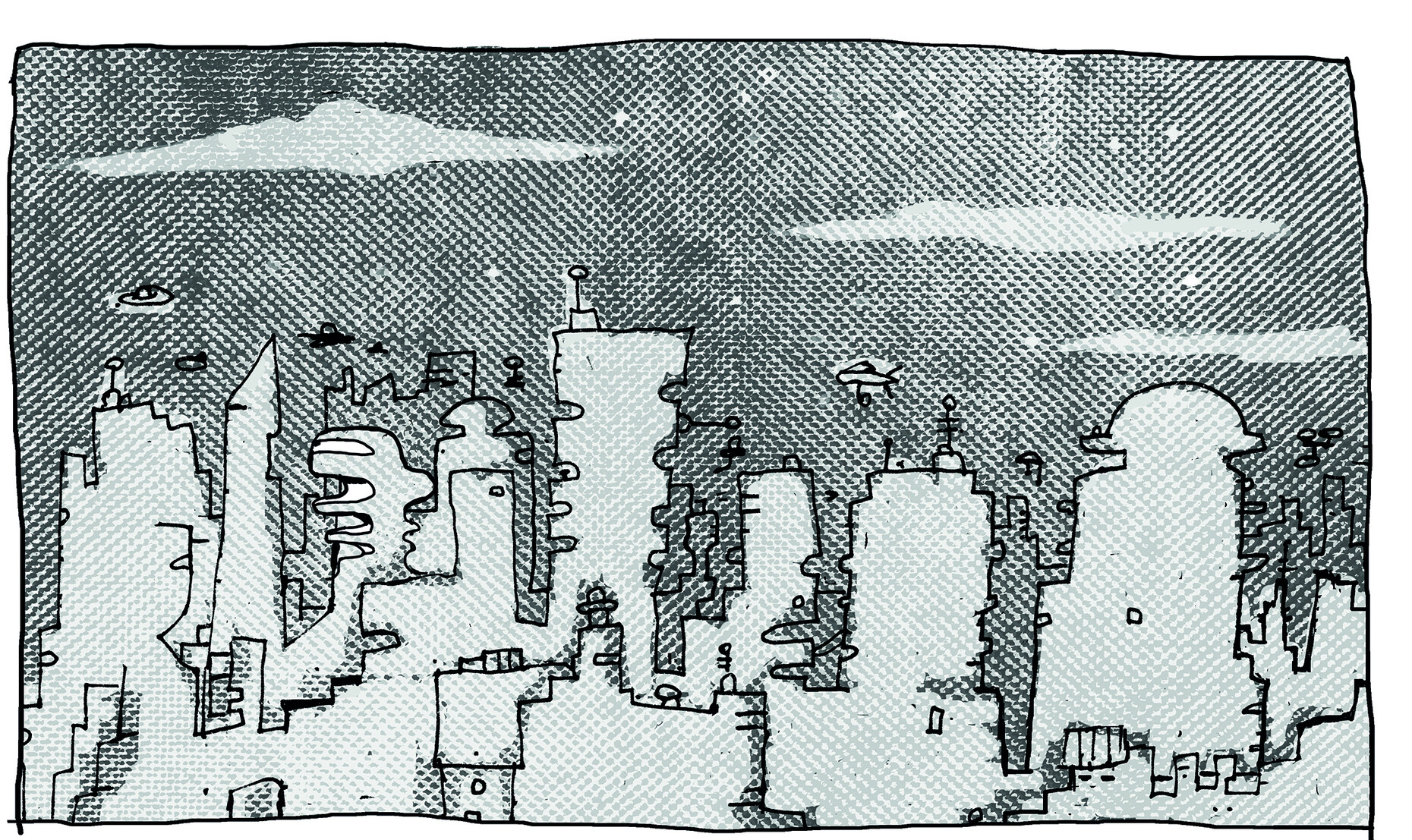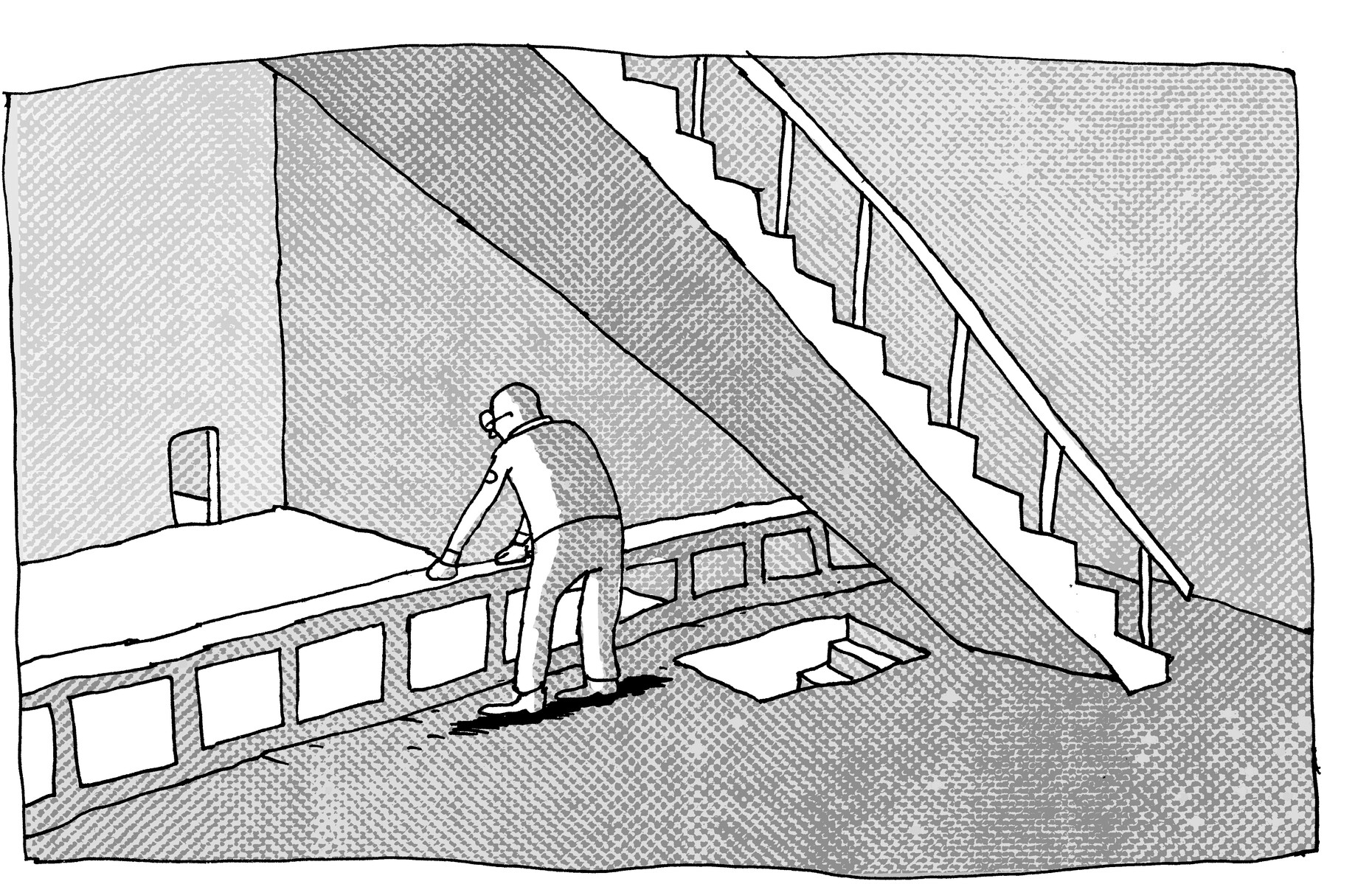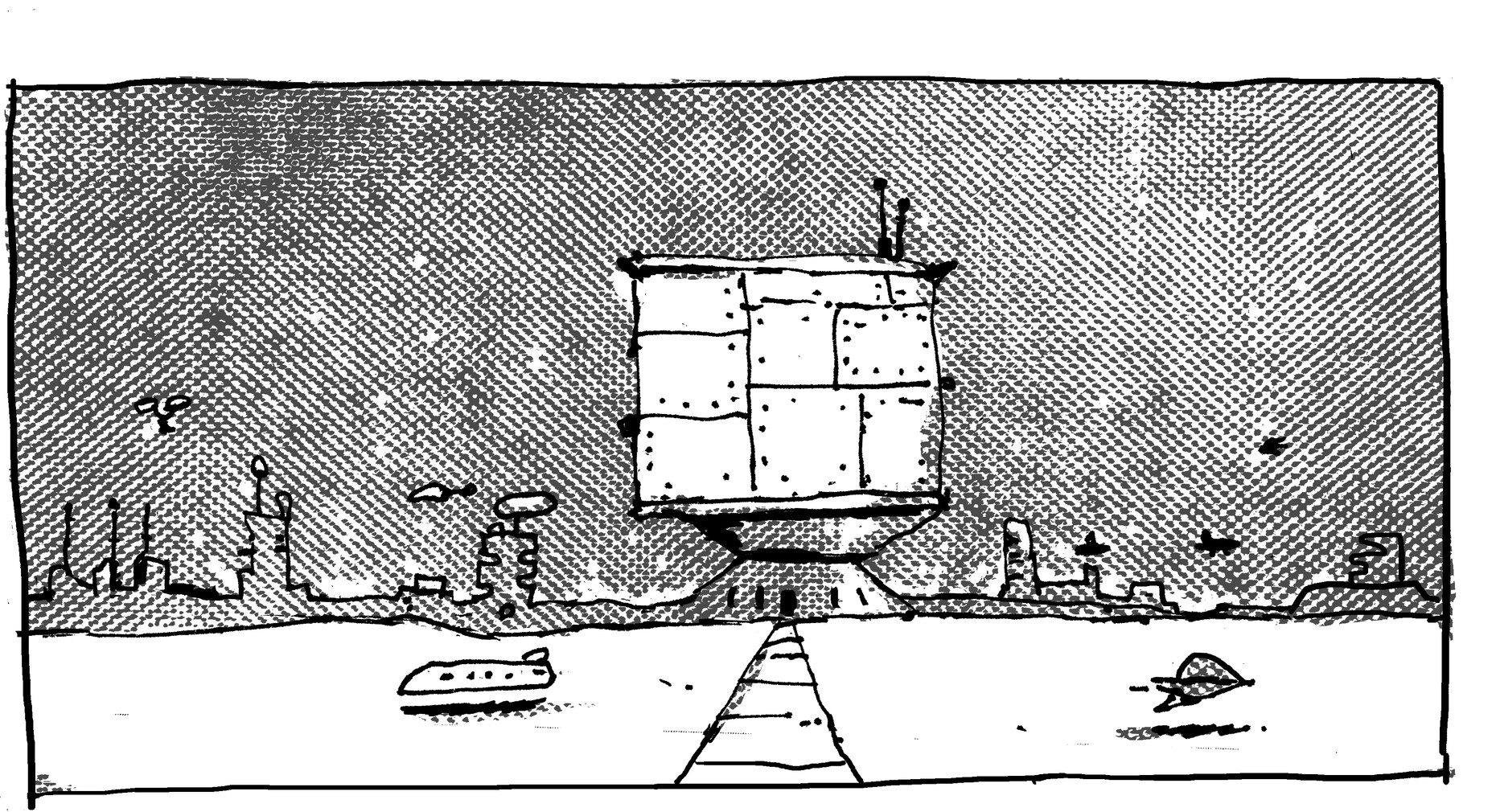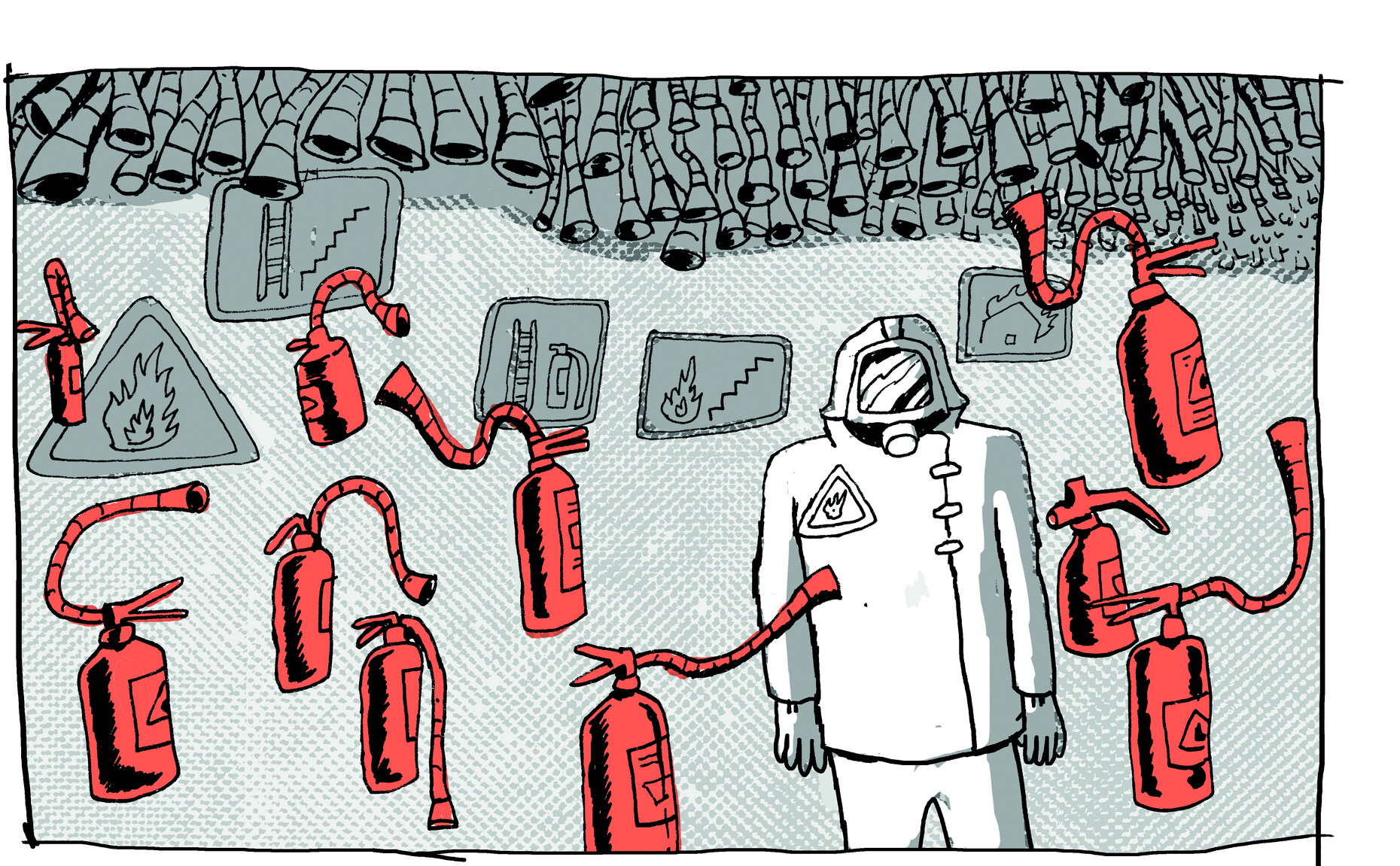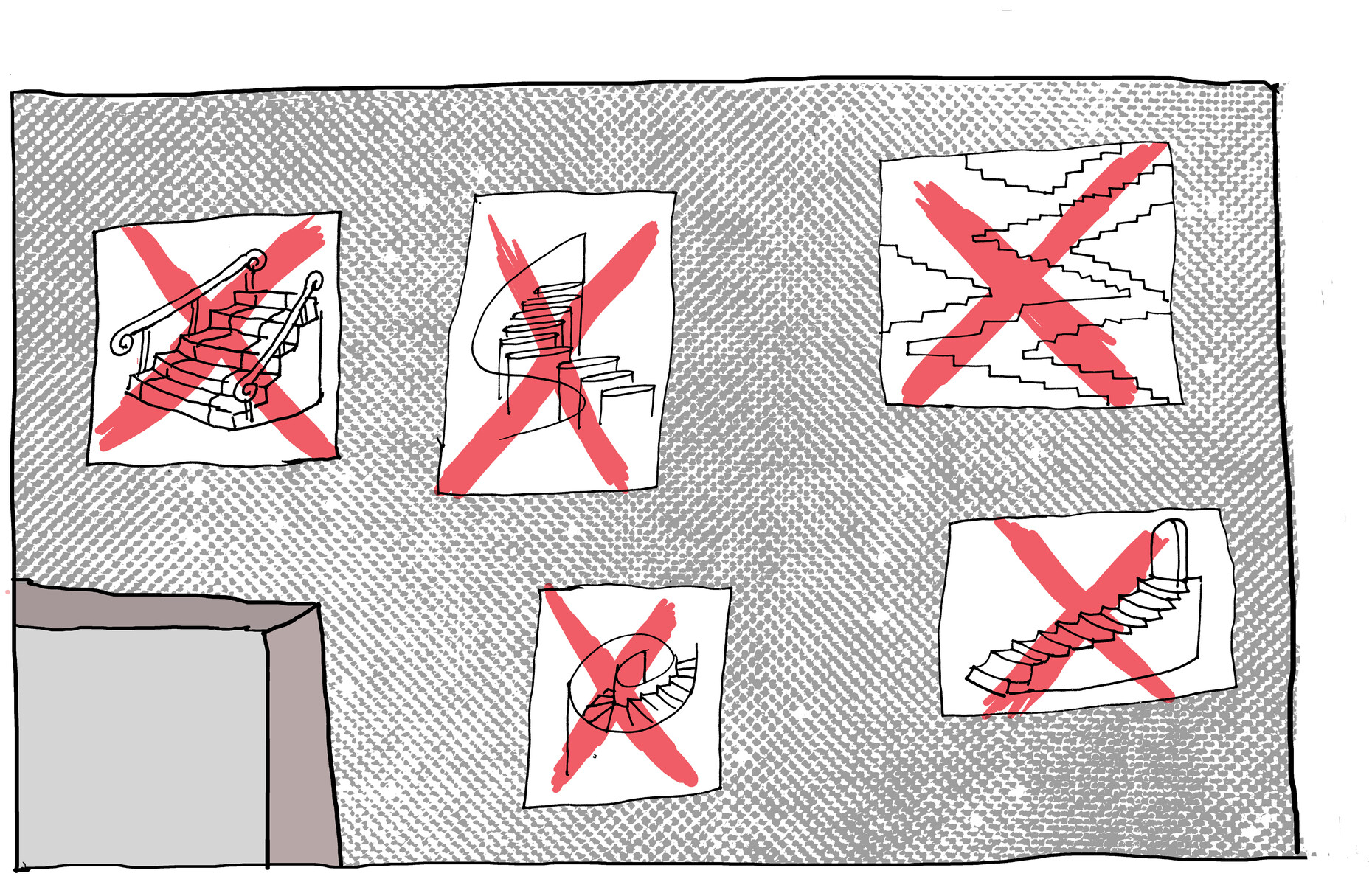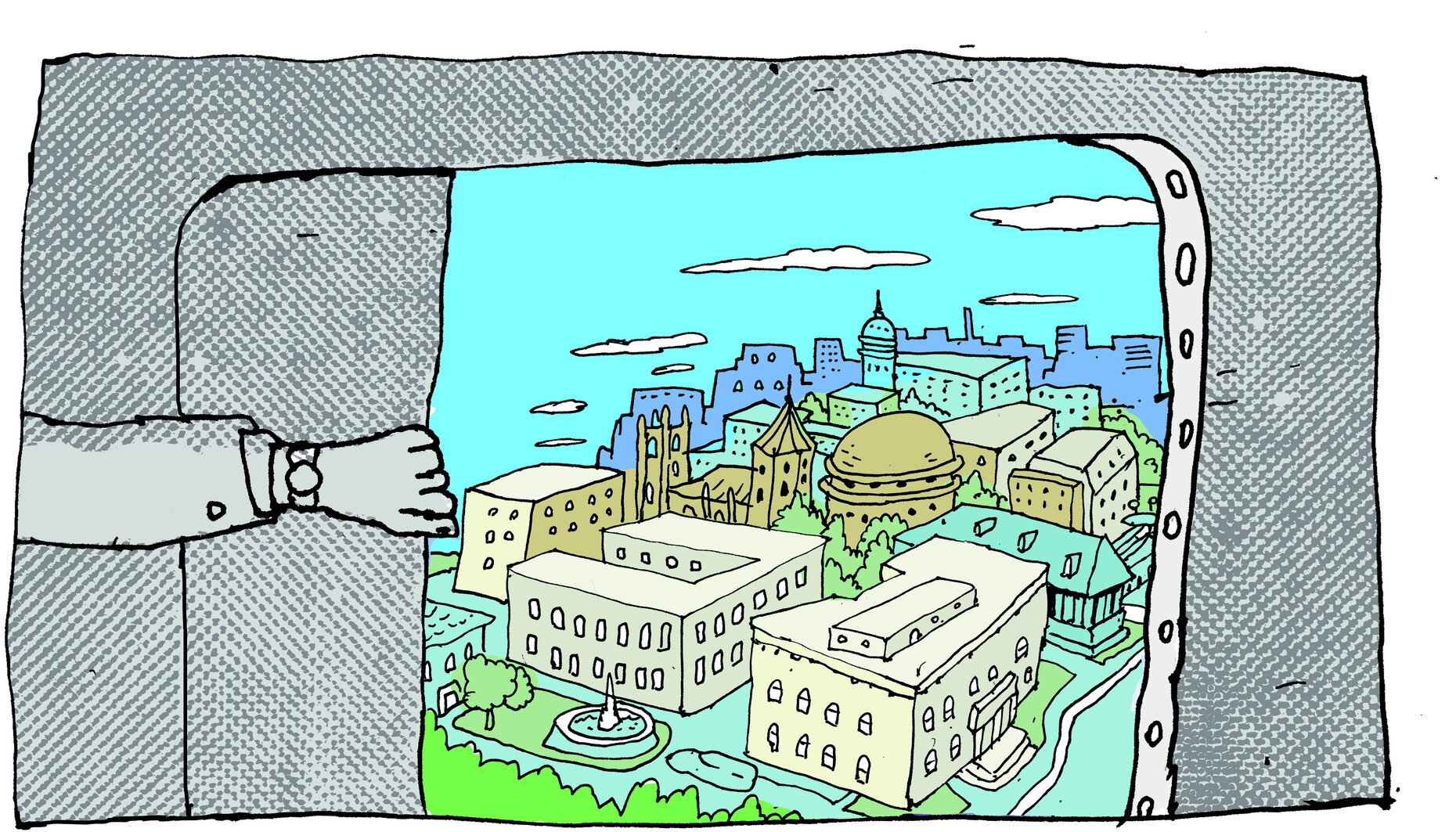A completely false and scurrilous architectural fairytale
This young man grew up in a country which is considered one of the safest in the world. What is more, a country that down through the years had gained a reputation as being the absolutely very best in a special field of economics, namely the invention of economization. Whether this had given rise to the affluence that its inhabitants were so proud of is something we just don’t know. Neither do we know whether they felt themselves to be especially fortunate. We can speak of them being satisfied to the extent that thanks to a plethora of laws, decrees and norms a feeling was kindled among the citizens that convinced them all that they no longer need concern themselves about anything anymore, as everything in their lives was subject to rules and regulations.
To name one example, and it defines the plot, Karl-Friedrich grew up in a house which he never left before adulthood. Now that is by no means unusual, as there would have been definitely no cause to do so. It was thus the case that he really only knew the building from the inside, although he could see on one of the countless screens scattered around the house and which also functioned as room dividers, what purportedly was happening outside the house and in the distance. His grandparents, who also lived in the house and who had grown up in an age when evidently life was still full of uncertainties, told him about the stench and noise to which people were exposed upon stepping outside their own four walls. And about the dangers of traffic, of unpleasant heat and cold, of ice and of water that plummeted from the skies. So Karl-Friedrich felt safe in the certainty of knowing that he had the privilege of growing up in the best of all possible worlds.*
For that reason he never asked questions about the house’s actual size or outer appearance. He only knew the apartment, which was admittedly so large that it straddled several stories. His parents praised the tranquility, as thanks to the regulations the country had enacted there was outstanding insulation from sources of noise. The people who lived upstairs or downstairs were not neighbors, but rather all those nice people who communicated through the social networks as if they were sitting directly opposite you. Since you could meet your friends in three-dimensional form in the social networks on the above-mentioned dividing walls, for example to eat together or simply swap ideas, nothing required the effort of having to go somewhere else. Only in very difficult situations, for example in the case of illnesses that could not be treated by following the on-screen instructions, did you step through one of the hatches on the ground floor into a self-driving vehicle. There you sat facing a monitor which offered a view of the surroundings similar to that offered by the screens at home.
Once a year, a chief operator from Facility Management dropped by to check that the apartment still fulfilled all its functions correctly. Actually, it sufficed to monitor the technical equipment that provided security and comfort from a central control command, not that anyone knew exactly where it was located. But the regulations said that a specialist should inspect the technical equipment on site. Karl-Friedrich always found those to be exciting days. The friendly man came bearing measuring appliances that enabled him to check not only whether the constant room temperature, air moisture and fine particle levels were not even one per thousand off, that lighting was an even 1.000 Lux, and the light color guaranteed in all corners of the apartment, but also, for example, whether the voice alarm was duly comprehensible in all rooms in the event of errors. He tested things by deliberately falling down the stairs to see whether the electronically controlled steps sensed the danger and in fractions of a second relinquished their hardness, become soft as rubber and the safety nets exploded into action to catch him softly before he hit the deck, something that always most impressed Karl-Friedrich. And that was only a few of the tests that had to be carried out.
Once, when the chief operator opened a small hatchway in the wall to make sure that the heat insulation had not been damaged, Karl-Friedrich was able to look out over the friendly man’s shoulder and to catch a glimpse of the outside world. The hatch flap was no more than 50 x 50 cm in size, meaning that it was like looking through an arrow slit in the heat-insulated wall. But how disappointed he was when the square of daylight revealed a view of a landscape that resembled the gray interior of a washing machine. Drones tasked with delivering supplies and disposing of waste flashed by sporadically, as did the occasional self-driving car, its windowless shell as gray as the walls of the surrounding buildings. Just as the otherwise taciturn man, who was completely absorbed in his work, was about to close the hatchway Karl-Friedrich noticed a slender entity with a pointed top stretching up far away on the horizon, its useless but striking decoration causing it to stand out from its gray surroundings. Karl-Friedrich asked what the comically pointy object that he could see in the far distance might be.
A smile flashed across the operator’s face. “That,” he explained, “is a piece of forgotten architecture.” “Architecture?” asked Karl-Friedrich, “What on earth is that?” “Well, that dates back to a time before the kind of things that I have to check came into existence or before there was any such thing as my profession. What you just saw over there in the distance is the tip of a church tower. People used to put up the kind of buildings that didn’t really have any proper function. People used to believe more than they knew and today we know more than we believe. For example, they not only believed in God and in Heaven; they also believed that the shapes of the objects that surrounded them, which included the buildings and even entire cities, should reflect their own worldview.” “So they were not at all interested in function, safety through technology, but only in appearance? Was that something that I once saw in a movie, what people used to call beauty?” “I’m not sure about that,” answered the man, “Whatever the case, they used to make things that could not be proved. At that time, the architect’s design accounted for 60 percent of overall building costs. And nowadays, when we no longer need architects, it is our outstanding technology that provides us with safety, guarantees our well-being and makes up between 60 and 70 percent of a building’s costs.” “Architects?” asked Karl-Friedrich. “Yes, architects. Those were the people who thought up how a building might look. Today, we can consider ourselves lucky to be able to plan much more accurately with computers and BIM. After all, it is these things that reliably use function, safety, energy input and material consumption, in other words all imaginable and calculable parameters, as exact data sets to produce flawless results. By contrast, architects were not experts on anything, they only knew a little bit about everything. Which is why every building looked different. How wasteful. Yes, those were the days of the multi-talents. You should know that it is only we, the specialists, who have made the world a safer place, who know how to use hardly any energy, to supply and erect everything at a low cost and in a controlled manner. And just how important the state considers those specialists, of whom I am one, you can see from the fact that, because of our valuable work, planning costs now represent over 30 percent of construction costs. Earlier, when there were still architects, this figure stood at between 15 and 18 percent of construction costs. No wonder that masses of people fell over balustrades that were too low, down stairs that were unsafe and could not read or write properly because the lux supply to their rooms was too low or the air too cold or its quality too poor or people were dropping like flies because of respiratory infections.”
“But the situation the way you describe it must have killed off more than 50 percent of the population,” remarked Karl-Friedrich. Annoyed, the chief operator went back to his work. “Just one more question please,” said Karl-Friedrich politely. “Are there any architects left and where do they learn their profession?” The man reluctantly replied that he didn’t know of any, but that he had heard that for people who were brave enough to find their way across the border there was, beyond that exemplary part of the world known as Technocratia, a totally underdeveloped and unsafe country where such strange professions as architecture did still exist. Karl-Friedrich watched the operator closely as he quickly shut the hatch in the wall. And he made a mental note of the number combination he needed to open it. Every day, when he thought that there was nobody around, he opened the peephole to the outside world and looked at the church tower he could see in the distance. And suddenly he was filled with a strange longing and a vague notion of a world to which he had not, to date, been party. He forced himself to contact a hacker who was able to help him to gain access to those sites on the Web that had been blocked. “Architecture?” the hacker was surprised. “Well I have had a whole load of weird requests, but architecture? That really is something completely different.”
And so Karl-Friedrich was able to get hold of a vast library consisting entirely of texts and images on architecture. Now, his day began at night, when everybody else in the house was asleep. And he not only lapped up the illustrations, but also devoted a great deal of time to studying floorplans, sections and elevations. He saw what beautiful houses and entire cities there must have been at one time and after one year he was familiar with all the big names that had left their mark on architecture over the centuries. Karl-Friedrich’s parents did not fail to notice the changes in their son and became very worried. They started thinking about psychiatric treatment, not on-screen and at home, as was usual, but about sending him to an outside specialist. But how surprised they were when Karl-Friedrich not only agreed to their wishes but even suggested a particularly effective form of treatment to them, one that would, however, necessitate a trip to Technocratia. “And there you will be in the best-possible hands,” his parents could not help exclaiming. They helped him to pack what he needed and ordered a self-driving capsule that would take Karl-Friedrich to the right place.
Karl-Friedrich had chosen this psychiatric practice carefully because it was situated right on the border with the neighboring country, the one about which the chief operator had talked. And not only that; it was also located in a building complex containing all kinds of institutions which not only permanently reinvented the laws, rules, standards and regulations, but also were very strict in making sure that they were observed. And of course there were reasons why these authorities and the psychiatric center formed a single unit. It was, as we have learnt, the border station between Technocratia and the country which, as Karl-Friedrich had now managed to find out, was called Culturia. In other words, that country where architecture apparently did still exist. The authorities had been put there in order to teach refugees who wanted to come over from Culturia to the other side something about safety, the fields of energy and economics, fire protection and controlling. The psychiatric center was in the same place because, as scientific data collection had shown, people moving abruptly from the belief-based principles of the one state to the demonstrable truths of the STEM subjects in the other could suffer a shock. However there were not yet any reliable figures on the subject, because so far there had not been any refugees wanting to cross the border between Culturia and Technocratia.
However, anybody intending to move in the opposite direction, i.e. to Culturia, needed initially to pass tests in his own country in order to protect anybody wanting to flee from supposed brainwashing by the other side. After all, as mentioned above, they believed that they were living in the best-possible world. But Karl-Friedrich was planning (as we, without actually stating it, can quite easily imagine) to turn his back on his homeland, which is why after submitting his application, something in itself not that easy, Karl-Friedrich had to visit a number of important officials personally. Just before the door he was addressed by an ancient beggar woman crouching to the right of the entrance. He started because he had never before come across such a person. Had she perhaps also tried to cross the border into the other country and failed? This thought bothered him, because it was a fate that he did not wish to share. So he took heart and asked her directly what circumstances had caused her to be crouching next to the entrance in such a dreadful state.
She claimed to be a former employee of a public building authority which had, however, closed down many years before. Her job had been to cut the fees of the architects she had to look after down to a minimum and regularly accuse them of neglect and inadequate planning. At the end of the day, doing this had amounted to cutting off her own nose to spite her face, since no architects had been prepared to work for the building authority that was her employer anymore. And then the authority itself had been shut down and she had, so to speak, been put out on the street from one day to the next. For many years now, she could not remember how many exactly, she had been trying to mend the damage she had done and to emigrate to Culturia. And for just as long she had been trying to pass the tests she had been set but had failed repeatedly. Karl-Friedrich listened to the story but did not know what to say to the woman, so he summed up his courage and entered the large building. The procedure that Karl-Friedrich had to submit to there took place in individual rooms organized by subject. After candidates had completed the test in one room they went on to a second one, then to a third and so on.
Karl-Friedrich now opened the door to the first room allocated to him. Over the lintel of the door was a sign marked “Fire Protection.” In the middle of the room stood a uniformed fireman in a respirator mask with several fire extinguishers strapped to his back. There were also countless fire extinguishers distributed around the room ready for use. Thousands of clearing nozzles decorated the ceiling, the walls were peppered with fire dampers and escape diagrams, fire curtains and loudspeakers for sounding auditory warnings. After the fire officer had taken off his respirator mask he asked Karl-Friedrich how many deaths the country could expect per year in domestic fires. “400,” said Karl-Friedrich, who had prepared himself very well and added, “but nobody knows how many of these people have died as a result of technical faults in their building and how many through human error.” “The figure is correct,” snapped the man, “but we will get a grip on the human error problem. We have vast research departments making new findings year after year, which they will then formulate into laws. Do you have any idea of the immense sums we invest in order to cut this figure of 400? We are not talking about peanuts here, but about many millions, if not billions.” Karl-Friedrich then said that he knew that around 200,000 people in the country died every year from cancer and just as many from cardiovascular disease. He added that 15,000 perished because of medical errors and between 5,000 and 6,000 in road accidents. He added, “If the billions poured into research and structural work were to be invested in the prevention and treatment of cancer and circulatory disorders, could not many more lives be saved?” This question elicited a fit of rage from the examiner. He turned bright red in the face, little flames escaped from his mouth, nose and ears. Karl-Friedrich grabbed one of the fire extinguishers lying about by its handle and directed its jet of fire-extinguishing foam into his interlocutor’s mouth, now wide open in rage. The latter fell instantly silent, opened his eyes wide and sank to the floor in a faint. And Karl-Friedrich headed for the door to the next room, which was marked “Safety for staircases, balustrades and emergency exits.”
This room boasted several levels. Opposite the door there was a gallery spanning the room at a great height, with an extremely high balustrade. The levels were connected by several flights of stairs, each of their steps marked with a bright, grooved strip at the front edge. There were large posters on the wall showing staircases, all of them with a red cross painted across them. Thanks to his research, Karl-Friedrich immediately recognized all the staircases that had been crossed out – the ones by Balthasar Neumann and Leonardo da Vinci, the Scala Regia and the Spanish Steps in Rome, as well as Niemeyer’s spiral staircase and Arne Jacobsen’s staircase for the National Bank of Denmark in Copenhagen. Suddenly a small but very wiry-looking little man in a nondescript gray suit was standing behind him, gesticulating wildly in the air, his folding yardstick extended and pointing. “None of that kind of thing is permitted. Unsafe, dangerous and not allowed,” he snapped. “Over there is how a staircase should look.” The little man directed his yardstick to the staircase leading to the gallery. Encouraged by the outcome of the first test Karl-Friedrich exclaimed, without hesitation: “But how ugly that staircase is – no undercut, all those handrails on the left and right and around the landings, those white strips, the way the individual steps are lit – nobody would want to go up or down a staircase like that.” “A staircase is not meant to be beautiful, but to be safe, young man,” admonished the little man. “I enjoy walking up and down the staircase because it is so safe and, on top of that, low in price, unlike any of those atrocious examples on the wall. If you refuse to believe me I will show you how it’s done,” and he started running up and down the staircase to the gallery. At the top he grabbed hold of the extremely high balustrade and held onto it for a moment as if calling out to Karl-Friedrich: “You see?” He turned around and went up and down, over and over again. Suddenly, on his tenth round, the tip of his shoe got briefly stuck on a piece of grooved safety trim at the front edge of the 34th step, he stumbled and his tie got caught in one of the balustrades, with their closely spaced posts. The tie then unfortunately roped itself around his neck and he found himself unable to breathe, with his body increasingly becoming victim to the laws of gravity. In the end he was just panting in short breaths, at which point Karl-Friedrich moved on to the next room.
“Controlling, Project Management, Investments, BIM” was the message on the electronic display panel. As soon as he entered the room Karl-Friedrich saw that the next examiner, a smart young man, was not only wearing a seemingly expensive pinstripe suit, but also that he had a Rolex watch on his wrist. He was playing absently with a car key which had a picture of a rearing black horse on its keyring. With the hint of a smile, this extremely eloquent man began talking at our friend about the successes achieved through controlling and project management, explaining how nowadays these could be used to chart all possible areas of life. Unable to control himself, Karl-Friedrich interrupted him: “As I can see, you have been extremely well schooled in talking and want to use your eloquence to convince me that the way you think and act is the right way. Incidentally, looking at you I can see that the suit you are wearing is made of cheap synthetics, your watch pirated in the Far East and the key on that stupid keyring comes from the first-aid kit here by the door. By the way, you will be saving the most money by deporting me straightaway.” The examiner was completely blown away by Karl-Friedrich’s interjection, which was as spontaneous as it was, incidentally, offensive. He could think of no reply and within a fraction of a second his blood pressure had shot up beyond the measurable scale. He wordlessly yanked open a hitherto invisible hidden door behind him leading to the neighboring country. This sprang open directly and he pushed Karl-Friedrich out into the open air.
And so, without having to undergo any more tests, our hero reached Culturia, where he found architecture. He studied, discovered the theater and concerts and became acquainted with literature and philosophy. Not that he neglected questions of economy and safety altogether. No, he designed the most beautiful staircases, the most beautiful balustrades, the most beautiful buildings and streets and the most beautiful cities. It might be true that not everything was as safe and well-regulated as it was in his homeland. But people took pleasure in his buildings and cities. They danced, sang in the rooms he had designed and enjoyed the stories about architecture. In the process, they learnt, as if in play, to assume responsibility for themselves, meaning that the state did not have to engage in excessive regulation. Indeed, through the education he had be able to enjoy by studying one of his favorite writers, from then on the following of the latter’s maxims was Karl-Friedrich’s constant companion, guiding his words and his thoughts: “Man only plays when he is a man in the fullest sense and he is only completely human when he plays.” **
* Voltaire, Candide: or the Optimist, 1759
** Schiller, Letters on the Aesthetic Education of Man, 1795
